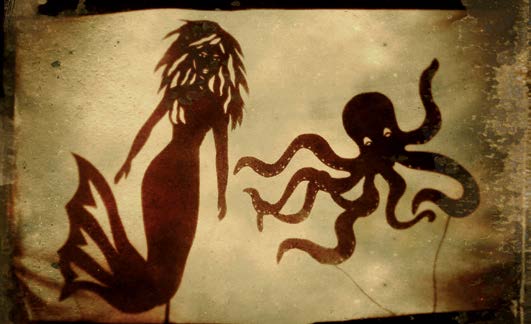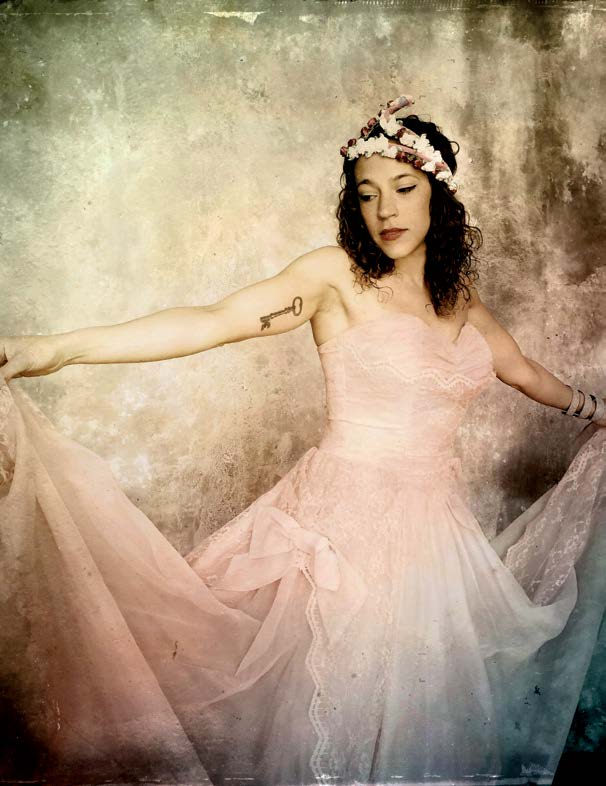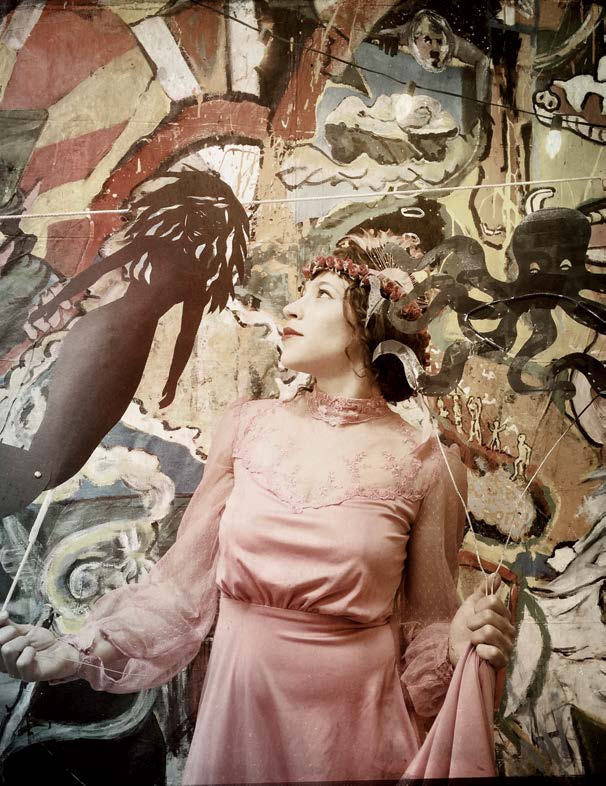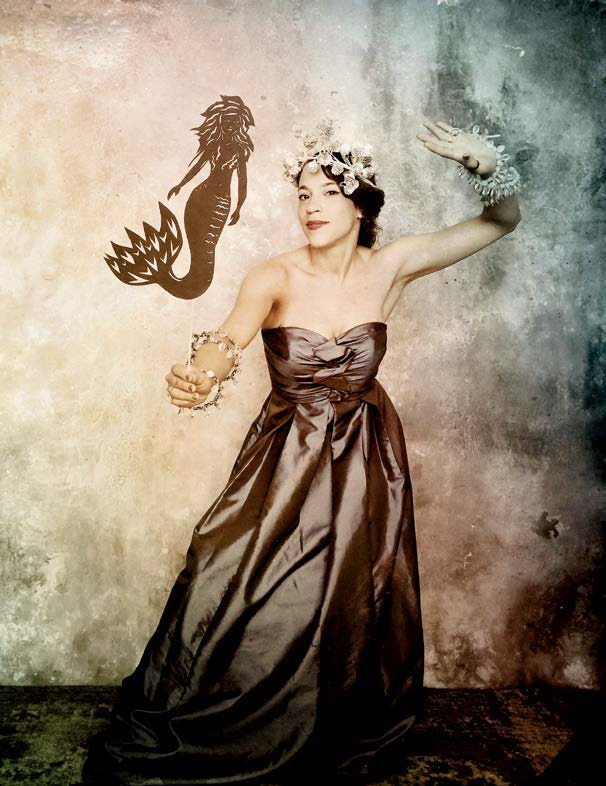Photography by WAXenVINE
A fairy, to Charlotte Lily Gaspard’s mind, “is a magical invisible being that helps us do the right thing, if we listen. People can call them whatever names they want,” she says, “spirit guides, earth spirits, angels, [but] being a fairy—or part—is committing to a lifestyle to bring magic to every situation and interaction.”
What is magic? “Magic is color, being excited about life and the present,” she says. “I used to leave love letters around New York City in unexpected places for strangers to find, little notes or flowers or unusual stones. I adorned the city with my own fairy illustrations and fairy stickers with messages that read: ‘Drink lots of water, darling’ or ‘Don’t forget to smell the flowers, ha-ha.’ Moments of magic are when people’s perspectives are changed, when something unexpected happens to surprise them out of the daily grind of their rhythm or rut. People forget how powerful we are, so much power, you can put out angry magic or hopeful magic, which is my true calling.”

If Charlotte is part celestial creature, she’s also part sophisticated human. A graduate of the prestigious Wesleyan College, where she majored in filmmaking, she recalls a childhood immersed in and enlivened by stories. Her parents worked in off-Broadway theater, and Charlotte followed them onto the stage, ultimately smitten by the spontaneity of labile art pictures, or shadow puppet theater.
“You can’t beat live theater. Something that cannot be captured and is in the moment is important to me,” says Charlotte, who now runs Midnight radio, an outdoor shadow puppet show accompanied by live music that brings new fairy tales to New Yorkers. The productions, supported by grants from The Brooklyn Arts Council and New York restoration Project, pop up in Brooklyn’s community vegetable gardens, which are planted, tended, and decorated by people in the neighborhood. By design, the shows in these eclectic organic gardens spark to life at dusk, “the magic hour, fairy time,” as Charlotte calls it. “Dusk is the transition from day to night, getting the light, losing the light, seeing the stars turn on,” she says. “It’s very powerful for the eyes, like lighting a candle. It’s hard not to be in the moment. Our shows give New Yorkers a chance to turn off the phones, unplug, experience something with all of their senses.”

Shadow puppet theater must have been birthed at dusk by the fairy muses attending the Chinese Emperor Wu of Han’s court officers as they desperately worked to grant their heartbroken sovereign’s fervent wish. Popular legend has it that the origins date from 400 BC, when Emperor Wu of Han, devastated by the death of his favorite concubine, commanded his guard detail to perform nothing less than a miracle: bring her back to life! Scrambling frantically to resurrect Han’s dead love, the court officers, as if by magical intervention, were suddenly inspired. Using donkey leather, they designed and constructed a doll of Han’s beloved, complete with moveable limbs. They placed it behind a screen and shone an oil lamp on “her,” which indeed gave the figure a “shadow life” of its own.

The shadow is a fundamental element of visual arts: from Turner to Hitchcock to Burlesque, it’s the “present absence” that tantalizes. As the legends of the Greek gods describe a deity sculpting man from clay, so does the artist sculpt with light and shadow. Shadow puppet theater (or shadow dance) is comprised of both the material (visceral dense objects) and the immaterial (the light or the shadow). Creating different perspectives, the shadow can be ominous or mysterious. If the object is the body, its shadow is its emotions. Shadow puppet theater has long been popular in Bali; their term for shadow puppet is Wayang kulit, meaning spirit skin. Charlotte creates her own postmodern spirit skin: using a bare backlight to project shadows of the puppet’s bodies on to the screen, she forms extraordinary imagery and mystical decor in an emotionally charged dancing storyboard set to music.

In ancient Chinese philosophy, we have a light side and a dark side, a Yin and Yang. The shadows depicted in Chinese philosophy are seen to represent our “dark selves.” Charlotte thinks about this a lot, she says—the juxtaposing sides of the elusive shadow in her theater art. “The dark self is all the things we push down, the parts of ourselves we deny, the parts that make us feel socially unacceptable, the secrets that make us feel guilty or weird. Make peace with your shadow. Give it a voice.”
Charlotte gives her shadows unique voices very far from that of the stereotypical wicked witch—the Manichean good vs. evil fairy tales we all grew up with and which baked into us basic Puritan morality. There are no villains in Charlotte’s shadow stories, “just good people who do bad things,” she says. “There are no bad people, just bad behaviors,” which she feels is the more realistic appraisal, if not the actual case most of the time. “Telling a visual story in shadows, you can give so much. The statuettes, the puppets, ask and invite the viewer to fill in details from their own imaginations to inform the story, or to create their own story.” As with rorschach inkblots, with very little suggestion we can create whole scenarios. “The shadow puppet stories wash over you and take you on a journey, a guided journey, a guided-imagery meditation, an adventure through space travel, or with mermaids, dragons, and true love.”

What is true love? “A willingness to risk it all, making that leap of faith that says you can love someone forever and they can reciprocate,” she effortlessly defines and follows up with a charming anecdote:
A businessman came to see one of Charlotte’s shadow puppet shows, a fairy tale she wrote about lovers who are separated and have to struggle to find each other again. The buttoned-down man came up to Charlotte afterwards—she was dressed in “full fairy regalia,” a ball gown and crown—and wept in her presence. Just like the children who long to touch her after the shows, try to kiss her face and hug her, the man reached out to Charlotte and told her how he and his wife had to fight for years to be together. Then, once they were finally able to unite, his wife-to-be took a job in Africa, and he was obliged to wait for her once again. “It seemed like a release for him, processing some feeling he hadn’t had the space to do before. A magical place, where he didn’t have to block out his shadow self and put on a brave face.”


































